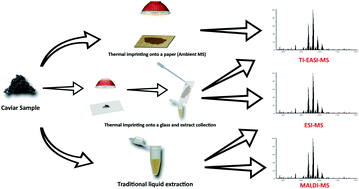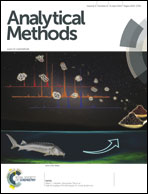High throughput MS techniques for caviar lipidomics
Abstract
The lipid profile of Sturgeon roe (caviar) was monitored by matrix assisted laser desorption/ionization mass spectrometry (MALDI(+)-MS), thermal imprinting easy ambient sonic-spray ionization mass spectrometry (TI-EASI(+)-MS) and electrospray mass spectrometry (ESI(+)-MS). Freshly salted and commercially salted pasteurized caviar samples of Atlantic sturgeon (Acipenser sturio) were stored either at +4 °C or at room temperature for 4 weeks. The different types of chemical information achieved by these MS techniques were compared: MALDI(+)-MS detects mainly phospholipids (PL) whereas TI-EASI(+)-MS allows monitoring of both triacylglycerols (TAG) and PL. ESI(+) coupled to Fourier transform ion cyclotron resonance high resolution mass spectrometer (FT-ICR-MS) and MS/MS experiments were used to fully characterize the detected lipids, ensure the absence of oxidation products in the degradation process and confirm the high efficiency of the thermal imprinting extraction. TI-EASI(+)-MS, via a more comprehensive profiling and easier operation, has therefore been demonstrated to provide caviar lipidomic profiles and discriminate its changes as a function of storage time and temperature. The data have also confirmed that hydrolysis is the main process of lipid degradation in caviar.

- This article is part of the themed collection: Analytical Sciences in Brazil

 Please wait while we load your content...
Please wait while we load your content...